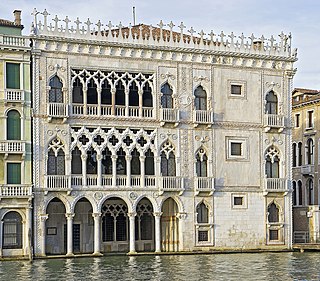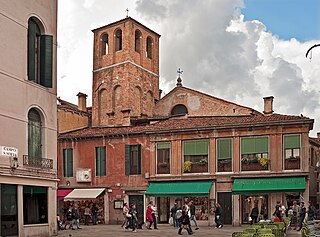
Andrea Mantegna was an Italian painter, a student of Roman archeology, and son-in-law of Jacopo Bellini.

The Ca' d'Oro or Palazzo Santa Sofia is a palace on the Grand Canal in Venice, northern Italy. One of the older palaces in the city, its name means "golden house" due to the gilt and polychrome external decorations which once adorned its walls. Since 1927, it has been used as a museum, as the Galleria Giorgio Franchetti.

Ca' Rezzonico is a palazzo and art museum on the Grand Canal in the Dorsoduro sestiere of Venice, Italy. It is a particularly notable example of the 18th century Venetian baroque and rococo architecture and interior decoration, and displays paintings by the leading Venetian painters of the period, including Francesco Guardi and Giambattista Tiepolo. It is a public museum dedicated to 18th-century Venice and one of the 11 venues managed by the Fondazione Musei Civici di Venezia.

The Basilica of San Petronio is a minor basilica and church of the Archdiocese of Bologna located in Bologna, Emilia Romagna, northern Italy. It dominates Piazza Maggiore. The basilica is dedicated to the patron saint of the city, Saint Petronius, who was the bishop of Bologna in the fifth century. Construction began in 1390 and its main facade has remained unfinished since. The building was transferred from the city to the diocese in 1929; the basilica was finally consecrated in 1954. It has been the seat of the relics of Bologna's patron saint only since 2000; until then they were preserved in the Santo Stefano church of Bologna.

St. Sebastian is the subject of three paintings by the Italian Early Renaissance master Andrea Mantegna. The Paduan artist lived in a period of frequent plagues; Sebastian was considered protector against the plague as having been shot through by arrows, and it was thought that plague spread abroad through the air.

Cagli is a town and comune in the province of Pesaro e Urbino, Marche, central Italy. It c. 30 kilometres south of Urbino. The Burano flows near the town.

The basilica diSan Pietro is a Catholic basilica and abbey in the Italian city of Perugia. Its bell tower, standing at 70 meters tall, is the tallest structure in Perugia and is one of the city's most significant symbols. It is an Italian national monument

Sant'Anna dei Lombardi,, and also known as Santa Maria di Monte Oliveto, is an ancient church and convent located in piazza Monteoliveto in central Naples, Italy. Across Monteoliveto street from the Fountain in the square is the Renaissance palace of Orsini di Gravina.

Bertoldo di Giovanni was an Italian Renaissance sculptor and medallist.
The decade of the 1460s in art involved some significant events.

San Francesco is a basilica church in Siena, Tuscany, Italy.

Santa Maria dei Carmini, also called Santa Maria del Carmelo and commonly known simply as the Carmini, is a large Roman Catholic church in the sestiere, or neighbourhood, of Dorsoduro in Venice, northern Italy. It nestles against the former Scuola Grande di Santa Maria del Carmelo, also known as the Scuola dei Carmini. This charitable confraternity was officially founded in 1597, and arose from a lay women's charitable association, the Pinzocchere dei Carmini. The members of this lay group were associated as tertiaries to the neighbouring Carmelite monastery. They were responsible for stitching the scapulars for the Carmelites.

Lorenzo di Bicci was an Italian painter of the Florentine School considered to be one of the most important painters in Florence during the second half of the 14th century. He is believed to have learned his trade from his father, about whom little is known. Lorenzo’s style, as well as that of his contemporaries Jacopo di Cione and Niccolò di Pietro Gerini, was influenced by the artist Andrea di Cione. Lorenzo's paintings made use of bright colors and his compositions avoided complexity. The figures he painted tended to have round faces and were often expressionless. Another one of Lorenzo's distinctive characteristics was his precision of execution. He was known for exceptional talent in drawing, an ability that he put to use at the initial stages of his painting. Unlike many celebrated Florentine artists of this period, Lorenzo mostly received commissions from the country clergy and from the lower-middle-class Florentine guilds. His successors, Bicci di Lorenzo and Neri di Bicci, continued to serve these groups.

Pistoia Cathedral, or Cathedral of Saint Zeno is the main religious building of Pistoia, Tuscany, central Italy, located in the Piazza del Duomo in the centre of the city. It is the seat of the Bishop of Pistoia and is dedicated to Saint Zeno of Verona.

Venetian painting was a major force in Italian Renaissance painting and beyond. Beginning with the work of Giovanni Bellini and his brother Gentile Bellini and their workshops, the major artists of the Venetian school included Giorgione, Titian, Tintoretto (1518–1594), Paolo Veronese (1528–1588) and Jacopo Bassano (1510–1592) and his sons. Considered to give primacy to colour over line, the tradition of the Venetian school contrasted with the Mannerism prevalent in the rest of Italy. The Venetian style exerted great influence upon the subsequent development of Western painting.

Volterra Cathedral is a Roman Catholic cathedral in Volterra, Italy, dedicated to the Assumption of the Virgin Mary. It is the seat of the bishop of Volterra.

San Sebastiano in Vallepiatta is an ancient church next to Piazzeta della Selva in Siena, Italy. It is located in the Contrada della Selva.

Santa Sofia is a church located in the sestiere (neighborhood) of Cannaregio in Venice, Italy. It should be distinguished from the palazzo Ca' d'Oro on the Grand Canal is also called the Palazzo Santa Sofia.

San Michele e San Francesco is a renaissance-style, Roman Catholic parish church located in the Piazza SS Francesco e Michele in the town of Carmignano, province of Prato, region of Tuscany, Italy. It is best known for housing the Jacopo Pontormo altarpiece of the Visitation.

The Pinacotecta Nazionale is an art gallery in Ferrara, Emilia-Romagna, Italy. It is located on the piano nobile of the Palazzo dei Diamanti, a work of Renaissance architecture by Biagio Rossetti, commissioned by Leonello d’Este in 1447. Not to be confused with the Civic Museum on the lower floor, which has hosted temporary exhibitions of contemporary art since 1992, the Pinacoteca houses a collection of paintings by the Ferrarese School dating from the thirteenth to the eighteenth centuries. It was founded in 1836 by the Municipality of Ferrara after Napoleon's widespread dissolution of churches threatened the protection of important public artworks. The gallery is formed as much around notable northern Italian painters as it is around the exquisite interior decoration of the palace itself, together with remnants of frescoes from local churches and later acquisitions from the Sacrati Strozzi collection.




















